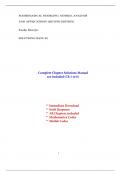MATHEMATICAL MODELING: MODELS, ANALYSIS
AND APPLICATIONS (SECOND EDITION)
Sandip Banerjee
SOLUTIONS MANUAL
Complete Chapter Solutions Manual
are included (Ch 1 to 6)
** Immediate Download
** Swift Response
** All Chapters included
** Mathematica Codes
** Matlab Codes
1
,Chapter 1 (Exercise)
1) The velocity u of propagation of deep ocean waves is a function of the
wavelength λ, acceleration g due to gravity and density ρ of the liquid.
By assuming that u = kλa g b ρc , where k is a dimensionless constant, a, b, c
are real numbers, find the relation between u, λ, g and ρ.
2) Which of the following equations contain an error and which are dimen-
sionally correct?
(i) v 2 = u2 + 2gz,
ρlu
(ii) p = ,
z
(iii) F = −pA,
1
(iv) p + ρu2 = −mgz,
2
where p is the pressure, ρ is the density, u and v are velocities, g is the
acceleration due to gravity, F is a force, m is a mass, A is an area, z and
l are lengths.
3) A man plans to build a garden, triangular in shape, such that the height
of the triangle is 4 ft shorter than the length of the base and also plans
to put a fence along the hypotenuse of the triangle. Write an equation to
model the length of the hypotenuse and obtain the value (in ft) that will
minimize the length of the hypotenuse.
4) The time of oscillation T1 of a small drop of liquid under surface tension
depends on thes density ρ, the radius r and the surface tension s and is
ρr3
given by T1 = . Check weather the equation is dimensionally correct
s
or not.
5) Suppose a company decides to make plastic container, which can hold
0.001 m3 (1 litre) of some powder. The container should have a circular
base, with double thickness at the top and the bottom. Let the cost of the
plastic sheet be $0.20 per square metre. Using the concept of mathemati-
cal modeling, obtain the most economical size of the plastic container for
the powder.
6) A person running a business, makes an initial investment of $2000 and
the cost of manufacturing each item is $15. Write a function to model
the total costs. Also, write a function to model the average cost per item.
Graphically, find the minimum of this function and interpret the result.
7) Due to the increase in global population, many environmentalists be-
lieve that the carrying capacity of the Earth (the maximum population
2
, Earth can sustain) depends not only on the finite natural resources of
the planet-water, land, air, and materials, but also on how the people use
and preserve the resources. The graphs show four different ways that a
growing population can approach its carrying capacity over time. Explain
each of the scenarios by analyzing the graphs.
8) In an environment, a new species has been introduced, which can affect
the growth of an existing species in various ways. The following graphs
show four hypothetical scenarios after Species A is introduced into an
environment where Species B is already present and living. Explain each
of the scenarios by analyzing the graphs.
9) Obtain the solution of the Gompertz growth model by solving the differ-
ential equation
!
dx k
= rx ln , x(0) = x0 ,
dt x
analytically. Hence, obtain the limiting value of x(t) as t → ∞.
10) Four different functions are described in the figures A, B, C and D. Match
each description with the appropriate graph.
(i) The concentration of the pollutant that pours into a lake is a function
of time and initially increases quite rapidly, but due to the natural mix-
ing and self-cleansing action of the lake, the concentration levels off and
stabilizes at some saturation level.
(ii) A train travels at a constant speed and its distance from the point of
origin is a function of time.
(iii) The population of a city, which is a function of time, starts increasing
rather slowly, but continues to grow at a faster and faster rate.
(iv) The production level at a manufacturing plant is a function of the amount
of money invested in the plant (capital outlay). At first, small increases
in capital outlay result in large increases in production, but eventually
the investors begin to experience diminishing returns on their money, so
3




